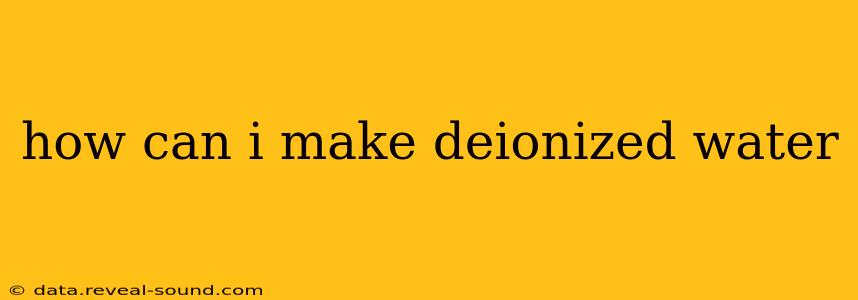How Can I Make Deionized Water?
Deionized (DI) water, also known as demineralized water, is water that has had its mineral ions removed. This process is crucial in many applications, from scientific research to industrial processes, where even trace minerals can interfere with results or equipment. While you can't easily make truly pure DI water at home without specialized equipment, understanding the process and the limitations will help you determine the best approach for your needs.
What is the process of deionization?
Deionization uses ion exchange resins to remove dissolved ions. These resins are typically composed of tiny beads that contain charged functional groups. As water flows through the resin bed, positively charged ions (cations) like calcium, magnesium, and sodium are attracted to negatively charged functional groups on the resin, and vice versa for negatively charged ions (anions). This effectively traps the ions, leaving behind purified water.
There are two main types of ion exchange resins:
- Cation exchange resins: These resins contain negatively charged functional groups that attract and bind positively charged ions.
- Anion exchange resins: These resins contain positively charged functional groups that attract and bind negatively charged ions.
A typical deionization system uses both cation and anion exchange resins, often arranged in a mixed bed for optimal performance.
How can I make deionized water at home? (Limitations and Alternatives)
Creating truly deionized water at home requires specialized equipment like a deionizer unit, which contains the ion exchange resins. These are not typically available for home use. However, there are methods to improve the purity of water that might suffice for certain applications:
1. Distillation:
Distillation involves boiling water and collecting the condensed steam. Many impurities remain behind in the boiling pot, resulting in purer water. While distillation removes many minerals, it doesn't completely remove all dissolved ions, and it won't remove volatile organic compounds. A simple distillation setup can be constructed at home with some effort, but it’s not as efficient as a commercial deionizer.
2. Reverse Osmosis (RO):
Reverse osmosis systems force water through a semipermeable membrane under pressure. This membrane blocks most dissolved solids, including mineral ions. RO systems are readily available for home use and provide much cleaner water than tap water. However, RO doesn't achieve the same level of purity as deionization, and some minerals might still remain.
3. Boiling and Filtering:
Boiling water for a few minutes can kill many microorganisms, but it doesn't remove dissolved minerals. Combining boiling with a high-quality water filter (activated carbon filter or other multi-stage filters) might improve the quality, but it will still not provide DI-water level purity.
What are the applications of deionized water?
The high purity of DI water makes it essential in various applications:
- Laboratory work: DI water is used to prepare solutions, rinse glassware, and conduct experiments where mineral contamination can affect results.
- Industrial processes: DI water is used in power generation, electronics manufacturing, pharmaceutical production, and other industries requiring high-purity water.
- Aquariums: In some sensitive aquarium setups, DI water is used as a base to create custom water parameters. (Caution: DI water is often too pure and needs to be remineralized).
- Automotive batteries: Adding DI water to car batteries helps maintain the electrolyte level.
How do I know if my water is deionized?
You cannot reliably test for deionized water at home. Commercial conductivity meters are used to measure the presence of ions in water—the lower the conductivity, the less ions are present. However, these meters are expensive and might not be practical for home use.
In conclusion, while achieving the level of purity found in true deionized water is difficult at home without specialized equipment, you can improve water purity through methods like distillation or reverse osmosis. Understanding the limitations of these methods is crucial to choosing the appropriate approach for your specific needs. Remember to always consider the intended application and potential consequences of using less-than-pure water.
